After successfully building a system for my Off-grid Cabin based on 6 panels, a Multiplus-II 5000/48 and 16 EVE 280AH battery I have started to look into putting something on the roof of my house. I have picked the gear I am somewhat familiar with, and with the money adds up, I am thinking that I am probably is making things more expensive than I need to do. At the same time, I am not super cost sensitive.
Overview
This is an overview of the build:
35 x 460w Jinko (JKM460M-60HL4) (6 will be mounted vertically facing SE to get the morning sun, and the rest on the roof at 35 degrees facing SW)
1x Fronius Symo 7.0.3 AC coupled inverter
3 x Victron MultiPlus 3000/48 DC Coupled Inverter/Charges
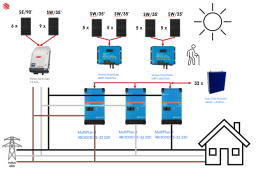
Consumption
This is the consumption from 2022, which is low since the pool was getting some maintenance, will be closer to 12.5 kWh going forward.
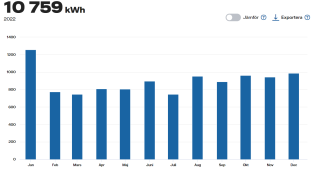
And this is the consumption a somewhat typical day (the first is a bit high side, had a couple of fans running after a small water leak, and the second is on the lower side):
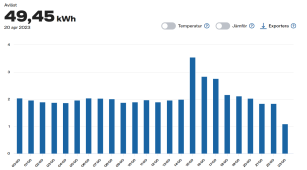
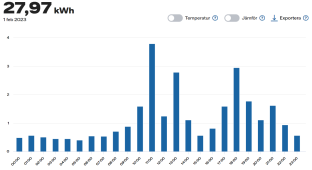
We don't charge any cars (nor drives a ton), but I want to overdimension the system a bit to have some marginals.
Financials -- costs and incomes, summary
This is my estimated costs and earnings from the build (based on European prices, but in USD):
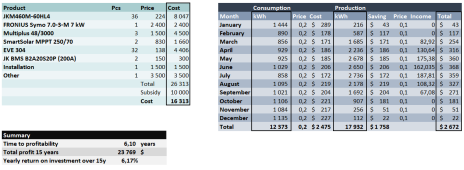
I would get a $10k subsidy, as long as I install a battery, which is great. But it's still a very costly system. I have only calculated on paying an electrician $1.5k to inspect the installation and connect it to the grid -- meaning that I have to do a lot of work myself, otherwise I basically have to add 10k to the price I recon.
I pay basically $0.2 for a kWh and will get about $0.1 kWh if I sell a kWh. I am in Sweden, so the production will be minimal November to February. The prices are estimates, we have had prices up towards $0.5 for a kWh this winter due to the Ukraine war, they are expected to drop down towards $0.15, but I am not so sure about that, I think we will see a much much bigger delta between high and low prices in the future depending on if there is wind and if the sun is shining. But nobody really knows.
At this rate, the build would become profitable after 6.1 years (assuming zero alternative return), and I there are always extra costs, so I wouldn't be suprised if it ends up being closer to 7-8 years. But with the above estimates, the yearly return over the coming 15 years would be 6.17%, which isn't that bad. I mostly make this build because its fun and good for the planet. I haven't calculated on how long it would take for the installation to pay of its CO2 debt -- but I think its closer to 7-8 years given the battery cells (don't really know how much energy it consumes to build them, but a monocrystaline cell built in China take like 5-6 years before its CO2 neutral and from then on its a 100% gain).
Questions!
Any input would be greatly appreciated! What changes would you guys do? Is the designed flawed in any way?
Does it make sense to have a MultiPlus II or should I go with a Phoenix? Or any other brand than Victron all together?
Overview
This is an overview of the build:
35 x 460w Jinko (JKM460M-60HL4) (6 will be mounted vertically facing SE to get the morning sun, and the rest on the roof at 35 degrees facing SW)
1x Fronius Symo 7.0.3 AC coupled inverter
3 x Victron MultiPlus 3000/48 DC Coupled Inverter/Charges

Consumption
This is the consumption from 2022, which is low since the pool was getting some maintenance, will be closer to 12.5 kWh going forward.

And this is the consumption a somewhat typical day (the first is a bit high side, had a couple of fans running after a small water leak, and the second is on the lower side):


We don't charge any cars (nor drives a ton), but I want to overdimension the system a bit to have some marginals.
Financials -- costs and incomes, summary
This is my estimated costs and earnings from the build (based on European prices, but in USD):

I would get a $10k subsidy, as long as I install a battery, which is great. But it's still a very costly system. I have only calculated on paying an electrician $1.5k to inspect the installation and connect it to the grid -- meaning that I have to do a lot of work myself, otherwise I basically have to add 10k to the price I recon.
I pay basically $0.2 for a kWh and will get about $0.1 kWh if I sell a kWh. I am in Sweden, so the production will be minimal November to February. The prices are estimates, we have had prices up towards $0.5 for a kWh this winter due to the Ukraine war, they are expected to drop down towards $0.15, but I am not so sure about that, I think we will see a much much bigger delta between high and low prices in the future depending on if there is wind and if the sun is shining. But nobody really knows.
At this rate, the build would become profitable after 6.1 years (assuming zero alternative return), and I there are always extra costs, so I wouldn't be suprised if it ends up being closer to 7-8 years. But with the above estimates, the yearly return over the coming 15 years would be 6.17%, which isn't that bad. I mostly make this build because its fun and good for the planet. I haven't calculated on how long it would take for the installation to pay of its CO2 debt -- but I think its closer to 7-8 years given the battery cells (don't really know how much energy it consumes to build them, but a monocrystaline cell built in China take like 5-6 years before its CO2 neutral and from then on its a 100% gain).
Questions!
Any input would be greatly appreciated! What changes would you guys do? Is the designed flawed in any way?
Does it make sense to have a MultiPlus II or should I go with a Phoenix? Or any other brand than Victron all together?
Last edited:




